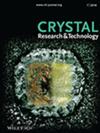CL‐20/DNDA5共晶结构的理论计算及MD模拟
IF 1.9
4区 材料科学
Q3 CRYSTALLOGRAPHY
引用次数: 5
摘要
为了研究CL‐20/DNDA5(2,4‐二硝基‐2,4‐二硝基戊烷)的共晶胞体结构和分子动力学(MD)模拟,预测了10种空间群晶体胞体的共晶结构。MD模拟在203、223、253、273、303和323 K的温度下进行。结果表明,P21/C的细胞参数与实验室制备的CL‐20/DNDA5共晶相似。随着温度的降低,每降低1 K,能量平均减少约17.7 kcal mol-1。径向分布函数表明CL‐20/DNDA5共晶形成的主要驱动力主要是CL‐20提供的H和DNDA5提供的O形成的氢键,范德华力和其他氢键起辅助作用。Hirshfeld表面分析表明,CL‐20/DNDA5的O··H对Hirshfeld表面接触点的贡献比CL‐20高4.5%,DNDA5的硝基具有更强的给电子能力。共晶生长形貌表明,模拟的理想晶体形态和实验制备的单晶均属于棱柱形晶体。本文章由计算机程序翻译,如有差异,请以英文原文为准。
Theoretical Calculation into the Structures and MD Simulation of CL‐20/DNDA5 Cocrystal
For studying the cocrystal cell structure and molecular dynamics (MD) simulation of CL‐20/DNDA5 (2,4‐dinitro‐2,4‐dinitropentane), cocrystal construction is predicted on ten kinds of space group of crystal cell. MD simulations are performed at the temperatures of 203, 223, 253, 273, 303, and 323 K. The results show that the cell parameters belonging to P21/C are similar to those of CL‐20/DNDA5 cocrystals which are prepared in the lab. With the decrease of temperature, the energy decreases by about 17.7 kcal mol–1 for every 1 K decrease on average. The radial distribution function shows that the main driving force for the formation of CL‐20/DNDA5 cocrystal is mainly the hydrogen bond formed by H provided by CL‐20 and O provided by DNDA5, the van der Waals force and other hydrogen bonds play an auxiliary role. The Hirshfeld surface analysis shows that the contribution of the CL‐20/DNDA5 O···H to the contact point at Hirshfeld surface is 4.5% higher than that of CL‐20 and the nitro of DNDA5 has the stronger electron donating ability. The morphology of cocrystal growth shows that both the simulated ideal crystal morphology and the single crystal prepared by the experiment belong to prismatic crystal.
求助全文
通过发布文献求助,成功后即可免费获取论文全文。
去求助
来源期刊
自引率
6.70%
发文量
121
审稿时长
1.9 months
期刊介绍:
The journal Crystal Research and Technology is a pure online Journal (since 2012).
Crystal Research and Technology is an international journal examining all aspects of research within experimental, industrial, and theoretical crystallography. The journal covers the relevant aspects of
-crystal growth techniques and phenomena (including bulk growth, thin films)
-modern crystalline materials (e.g. smart materials, nanocrystals, quasicrystals, liquid crystals)
-industrial crystallisation
-application of crystals in materials science, electronics, data storage, and optics
-experimental, simulation and theoretical studies of the structural properties of crystals
-crystallographic computing

 求助内容:
求助内容: 应助结果提醒方式:
应助结果提醒方式:


